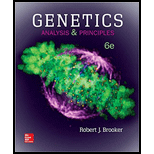
Concept explainers
To review:
The flow of information in the genes could be explained through the theory of central dogma.
Introduction:
In 1958, Francis Crick stated that central dogma is the process of transferring information into the protein, whichcannot be retrieved. The transfer from protein towards protein or protein to
Explanation of Solution
In 1970, Crick again restated his statement, which stated that the detailed transfer of information cannot get transferred from protein and this is the main basis for central dogma. In simple words, the pathway for information in from DNA (deoxy ribonucleic acid) to RNA (ribonucleic acid) and then to protein. While according to James Watson, central dogma, the flow of information only takes place in two parts; one is from DNA to RNA and the other is from RNA to protein.
Replication- both, the somatic as well as the genetic DNA gets replicated in order to get a progeny of any cell. This is the primary step for
Transcription- the process of conversion of a particularDNA strand to mRNA(messenger RNA) with the help of RNA polymerase enzyme is called transcription. Formation of RNA strand that links the
Translation- this is the second step of central dogma, wherein RNA gets converted to a long chain of amino acids called proteins done by tRNA (transfer RNA). The tRNA carries amino acid to the 3` ends, which gets along the protein chain.
The replication of RNA is called RNA replication, whereas the synthesis of DNA using an RNA template is termed as reverse transcription. By the use of E. coli (Escherichia coli), direct replication could be done from DNA to proteins in a test tube.
Therefore, it can be concluded that biopolymers have three major classes as DNA, RNA, and proteins and the conversion of DNA to RNA and RNA to proteins is termed as central dogma. In humans, there are 23 pairs of chromosomes and each cell has two copies. Firstly, unwinding and RNA synthesis takes place. Secondly, re-winding and release of pre-mRNA takes place, which gives DNA and pre-mRNA. Thirdly, tRNA molecules bind with the binding sites of the ribosomes of mRNA via hydrogen bonding. After the formation and breaking of several peptide bonds, the desired proteins are formed.
Want to see more full solutions like this?
Chapter 12 Solutions
GENETICS:ANALYSIS+PRIN.(LL)-W/ACCESS
- please fill in the empty sports, thank you!arrow_forwardIn one paragraph show how atoms and they're structure are related to the structure of dna and proteins. Talk about what atoms are. what they're made of, why chemical bonding is important to DNA?arrow_forwardWhat are the structure and properties of atoms and chemical bonds (especially how they relate to DNA and proteins).arrow_forward
- The Sentinel Cell: Nature’s Answer to Cancer?arrow_forwardMolecular Biology Question You are working to characterize a novel protein in mice. Analysis shows that high levels of the primary transcript that codes for this protein are found in tissue from the brain, muscle, liver, and pancreas. However, an antibody that recognizes the C-terminal portion of the protein indicates that the protein is present in brain, muscle, and liver, but not in the pancreas. What is the most likely explanation for this result?arrow_forwardMolecular Biology Explain/discuss how “slow stop” and “quick/fast stop” mutants wereused to identify different protein involved in DNA replication in E. coli.arrow_forward
- Molecular Biology Question A gene that codes for a protein was removed from a eukaryotic cell and inserted into a prokaryotic cell. Although the gene was successfully transcribed and translated, it produced a different protein than it produced in the eukaryotic cell. What is the most likely explanation?arrow_forwardMolecular Biology LIST three characteristics of origins of replicationarrow_forwardMolecular Biology Question Please help. Thank you For E coli DNA polymerase III, give the structure and function of the b-clamp sub-complex. Describe how the structure of this sub-complex is important for it’s function.arrow_forward
 Biology (MindTap Course List)BiologyISBN:9781337392938Author:Eldra Solomon, Charles Martin, Diana W. Martin, Linda R. BergPublisher:Cengage Learning
Biology (MindTap Course List)BiologyISBN:9781337392938Author:Eldra Solomon, Charles Martin, Diana W. Martin, Linda R. BergPublisher:Cengage Learning Concepts of BiologyBiologyISBN:9781938168116Author:Samantha Fowler, Rebecca Roush, James WisePublisher:OpenStax College
Concepts of BiologyBiologyISBN:9781938168116Author:Samantha Fowler, Rebecca Roush, James WisePublisher:OpenStax College Human Heredity: Principles and Issues (MindTap Co...BiologyISBN:9781305251052Author:Michael CummingsPublisher:Cengage Learning
Human Heredity: Principles and Issues (MindTap Co...BiologyISBN:9781305251052Author:Michael CummingsPublisher:Cengage Learning- Case Studies In Health Information ManagementBiologyISBN:9781337676908Author:SCHNERINGPublisher:Cengage
 Biology 2eBiologyISBN:9781947172517Author:Matthew Douglas, Jung Choi, Mary Ann ClarkPublisher:OpenStax
Biology 2eBiologyISBN:9781947172517Author:Matthew Douglas, Jung Choi, Mary Ann ClarkPublisher:OpenStax Biology: The Dynamic Science (MindTap Course List)BiologyISBN:9781305389892Author:Peter J. Russell, Paul E. Hertz, Beverly McMillanPublisher:Cengage Learning
Biology: The Dynamic Science (MindTap Course List)BiologyISBN:9781305389892Author:Peter J. Russell, Paul E. Hertz, Beverly McMillanPublisher:Cengage Learning





